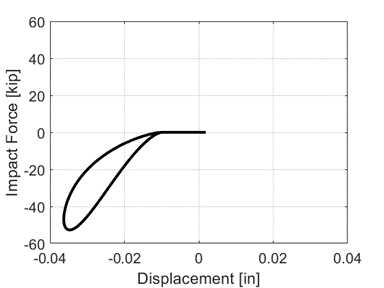3.1.5.30. Hertz Damp Material
This command is used to construct the uniaxial Hertz Damp Material
- uniaxialMaterial Hertzdamp $matTag $Kh $xiNorm $gap <$n>
Argument |
Type |
Description |
|---|---|---|
$matTag |
integer |
integer tag identifying material. |
$Kh |
float |
nonlinear Hertz contact stiffness. |
$xiNorm |
float |
normalized impact damping ratio. |
$gap |
float |
initial gap. |
$n |
float |
indentation exponent (optional with default value of: 1.5). |
Note
This material is implemented as a compression-only gap material, so $gap should be input as a negative value.
This material model follows the constitutive law
\[f_c (t) = k_h (\delta(t) -g)^n + c_h \dot{\delta}(t)\]
where t is time, \(f_c (t)\) is the contact force, \(k_h\) is the nonlinear Hertz contact stiffness ($Kh), \(\delta(t)\) is the indentation, g is the initial gap ($gap), n is the indentation exponent ($n), and \(\dot{\delta}(t)\) is the indentation velocity. The damping coefficient \(c_h\) is computed as
\[c_h = \overline{\xi} \frac{k_h}{\dot{\delta}_0} (\delta(t) - g)^n\]
where \(\dot{\delta}_0\) is the pre-impact indentation velocity. The normalized impact damping ratio \(\overline{\xi}\) ($xiNorm) is usually related to the coefficient of restitution, represented by e. The recommended form of \(\overline{\xi}\) is
\[\overline{\xi} = \frac{8}{5} \frac{1-e}{e}\]
Response of the Hertzdamp material during impact:
Note that the flat displacement from 0 to roughly minus 0.01 inch displacement is caused by the gap parameter.
Code Developed by: Patrick J. Hughes, UC San Diego
Lankarani HM, Nikravesh PE. A Contact Force Model with Hysteresis Damping for Impact Analysis of Multibody Systems. Journal of Mechanical Design 1990; 112(3): 369–376. DOI: 10.1115/1.2912617.
A Hertz contact model with non-linear damping for pounding simulation. Earthquake Engineering and Structural Dynamics 2006; 35(7): 811–828. DOI: 10.1002/eqe.557.
Ye K, Li L, Zhu H. A note on the Hertz contact model with nonlinear damping for pounding simulation. Earthquake Engineering and Structural Dynamics 2009; 38: 1135–1142. DOI: 10.1002/eqe.
Evaluation of uniaxial contact models for moat wall pounding simulations. Earthquake Engineering and Structural Dynamics 2020(March): 12–14. DOI: 10.1002/eqe.3285.
